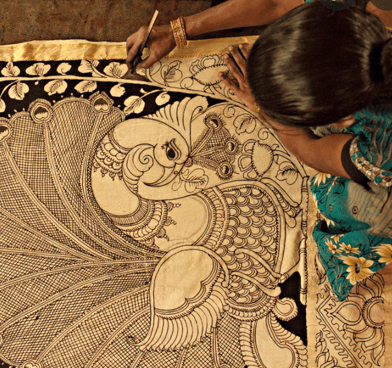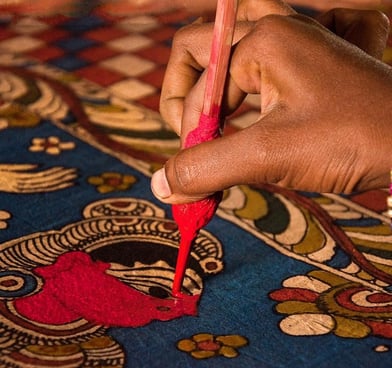Kalamkari - Colors of Dawn
The Textile Art of Andhra Pradesh




Pic Courtesy: D'Source.in
With a history of over 3000 years, the beautiful art of Kalamkari from Andhra Pradesh is an ancient style of hand painting done on cotton or silk fabric with a tamarind pen, using natural dyes. While art similar to Kalamkari has been found at Mohenjodaro excavations (a key archaeological site of the ancient Harappan civilization), it is believed to have flourished and reached its peak under Mughal patrons governing the Golconda Sultanate and Coromandel Provinces.
The word Kalamkari is derived from the Persian word 'qalam' (pen) and ‘kari' (craftsmanship). Typical motifs include flowers, animals, birds, paisleys, and scenes from mythology and the epics - showing gods, humans and demons. The artists use burnt tamarind twigs as their pens to sketch, and special bamboo reeds (which have cloth tied on it) to paint. They use earthy and soothing colours such as indigo blue, mustard yellow, rust red, black and sap green. Think of the inky night sky flushed with golden light of the morning sun, bathing the brown earth and the lush greenery with its mellow shades - the soft colours of dawn!
These colours are extracted directly from fruit peels, flowers, roots, minerals, vegetables and barks, making them truly a gift from Mother Nature's basket.
A distinct feature of this beautiful art form is that it goes through a minimum of 10 steps, before the painted fabric is ready – from being washed in fresh flowing river water, to being soaked in a buffalo milk solution, to being treated with myrobalan seeds.
The two main styles are: Machilipatnam style and Srikalahasti style. The former involves block printing with hand-carved blocks followed by intricate detailing, while the latter is completely hand-drawn and filled with colours, and focuses on divine scenes from the religious epics and folklore, due to its story-telling origins and connect with temples. Both styles derive their names from the respective towns – Machilipatnam and Srikalahasti (in Chittoor district) – where they originated, and are still widely practiced.
In an age where harmful chemical dyes and colour treatment of cloth is leading to skin allergies in young and old, the elegant Kalamkari fabric is a true winner with its naturally dyed soft fabrics. Kalamkari can easily last for years with no change in texture or colour, and is very skin-friendly (hypoallergenic) due to its nature-based colours and methodical painting technique.
While the popularity of Kalamkari art has soared over the years, and is widely adopted into textiles (sarees, stoles and tunics) and accessories (bags, purses and wallets), this timeless art is facing a serious threat from fake Kalamkari prints that have flooded the urban market – owing to its high demand. These look-alike Kalamkari materials are simply 'screen-printed' (not hand block-printed or painted) in high volume, use chemical colours and lack the authenticity of the artisan's creative expression, which he/she caringly customizes for patrons. While it is difficult for the untrained eye to spot the difference between authentic and fake Kalamkari, one way is to check the colours - screen-printed fake Kalamkari fabric often has very bright colours whereas authentic handmade Kalamkari usually has softer, muted colours.
